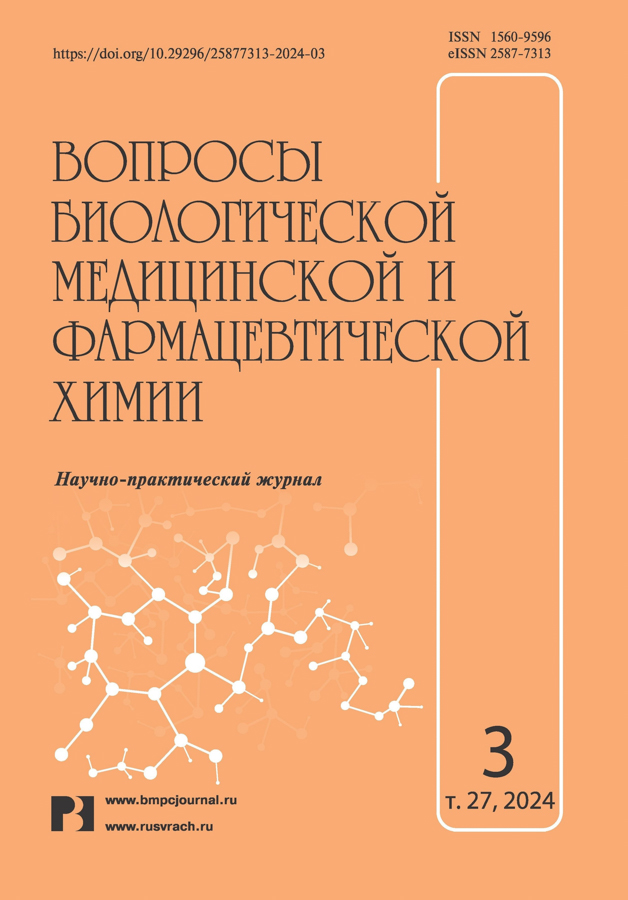Взаимосвязь между биохимическими показателями и фенотипическими признаками тимьяна обыкновенного (Thymus vulgaris L.)
- Авторы: Маланкина Е.Л.1, Ткачёва Е.Н.1, Аль Карави Х.А.2
-
Учреждения:
- Российский государственный аграрный университет – МСХА имени К.А.Тимирязева
- Университет Вавилона
- Выпуск: Том 27, № 3 (2024)
- Страницы: 23-29
- Раздел: Фармацевтическая химия
- URL: https://journals.eco-vector.com/1560-9596/article/view/629290
- DOI: https://doi.org/10.29296/25877313-2024-03-04
- ID: 629290
Цитировать
Полный текст
Аннотация
Введение. Тимьян обыкновенный (Thymus vulgaris L.) является востребованной лекарственной культурой, сырьё которой входит в фармакопеи ряда стран и широко применяется научной медициной. В связи с наличием у тимьяна обыкновенного сильного внутривидового разнообразия, представляется интересным выявление фенотипических признаков, указывающих с большой долей вероятности на присутствие тех или иных фармакологически значимых соединений. Наличие подобных сведений позволит вести целенаправленный отбор как в природных популяциях, так и при гибридизации культиваров и выведении новых сортов.
Цель работы ‒ выявить фенотипические признаки тимьяна обыкновенного, указывающие на высокое содержание эфирного масла и тимола в нём, суммы фенольных соединений, флавоноидов и дубильных веществ.
Материал и методы. В качестве объектов выбраны образцы и сорта тимьяна обыкновенного различного географического происхождения. Биометрические, анатомические показатели и урожайность определяли в фазе цветения. Содержание эфирного масла выявляли методом гидродистилляции по Клевенджеру, компонентный состав – методом газовой хроматографии. Сумму фенольных соединений и дубильных веществ находили по методу Фолина‒Чокальтеу в водно-спиртовой вытяжке в пересчёте на галловую кислоту. Определение флавоноидов в водно-спиртовой вытяжке проводили спектрофотометрическим методом в пересчёте на рутин.
Результаты. В результате исследований не обнаружено признаков, указывающих на высокое содержание эфирного масла. Содержание флавоноидов имеет отрицательную корреляцию (‒0,72) с плотностью устьиц. Отмечена отрицательная зависимость между интенсивностью окрашивания пестика и пыльников и содержанием суммы фенольных соединений в пересчёте на галловую кислоту (0,71 и 0,72 соответственно). Крупные устьица как на нижней, так и на верхней стороне листа с очень высокой долей вероятности указывают на повышенное содержание дубильных веществ в пересчёте на галловую кислоту (0,8 и 0,88). Все изученные образцы тимьяна обыкновенного относились к тимольному типу, содержание этого компонента находилось в пределах 37,6‒80,8%. На повышенное содержание тимола в эфирном масле могут указывать такие признаки, как удлинённая форма листа (индекс листа R = 0,78), отсутствие закручивания вниз краёв листовой пластинки (R = ‒0,78) и выраженность жилок на нижней стороне листа (R = 0,92). Крупные устьица на нижнем эпидермисе также указывают на повышенную долю тимола в эфирном масле (R = 0,78). При анализе взаимозависимости между содержанием главных компонентов эфирного масла отмечено, что существует тесная отрицательная корреляция между содержанием р-цимола и тимолом (R = ‒0,91), а также карвакролом (R = ‒0,88).
Выводы. Выявлены фенотипические и анатомические признаки, позволяющие диагностировать перспективные образцы тимьяна обыкновенного, которые помогут ускорить селекционный процесс.
Ключевые слова
Полный текст
Об авторах
Е. Л. Маланкина
Российский государственный аграрный университет – МСХА имени К.А.Тимирязева
Автор, ответственный за переписку.
Email: gandurina@mail.ru
д.с.-х.н., профессор
Россия, МоскваЕ. Н. Ткачёва
Российский государственный аграрный университет – МСХА имени К.А.Тимирязева
Email: gandurina@mail.ru
к.с.-х.н.
Россия, МоскваХ. А.Х. Аль Карави
Университет Вавилона
Email: gandurina@mail.ru
Колледж науки, биологический факультет
Ирак, ВавилонСписок литературы
- Mewes S., Krüger H., Pank F. Physiological, morphological, chemical and genomic diversities of different origins of thyme (Thymus vulgaris L.). Genet Resour Crop Evol. 2008; 55: 1303–1311.
- Buzuk A., Buzuk G., Leshev S. et al. Variability in essential oil compositions of Thymus pulegioides L. and Thymus serpyllum L. growing in the Republic of Belarus. American Journal of Essential Oils and Natural Products. 2017; 5(3): 25–31.
- Rustaieea A., Yavari A., Nazerib V. et al. Genetic Diversity and Chemical Polymorphism of Some Thymus Species. Chemistry & Biodiversity. 2013; 10: 1088–1098.
- Государственная фармакопея Российской Федерации XIV издания. Том IV/Министерство здравоохранения Российской Федерации. URL: https://docs.rucml.ru/feml/phar-ma/v14/vol4/1287/ (дата обращения: 30.03.2023).
- Wesołowska A., Jadczak D. Comparison of the Chemical Composition of Essential Oils Isolated from Two Thyme (Thymus vulgaris L.) Cultivars. Not Bot Horti Agrobo. 2019; 47(3): 829–835.
- Malankina E.L., Kozlovskaya E.L., Kuzmenko A.N. et al. De-termination of the component composition of essential oil of thyme species by the method of gas chromatograph. Moscow University Chemistry Bulletin. 2019; 74(6): 310–314.
- LeBel G., Vaillancourt K., Bercier P. et al. Antibacterial activity against porcine respiratory bacterial pathogens and in vitro biocompatibility of essential oils. Arch Microbiol. 2019; 201: 833–840.
- Krause S., Liaob P., Crocollc Chr. et al. The biosynthesis of thymol, carvacrol, and thymohydroquinone in Lamiaceae proceeds via cytochrome P450s and a short-chain dehydrogenase. PNAS. 2021; 118: 52 e2110092118; https://doi.org/10.1073/pnas.2110092118.
- Маланкина Е.Л., Ткачёва Е.Н., Аль Карави Х. и др. Варьирование биохимических показателей сырья тимьяна ползучего (Thymus serpyllum L.) в зависимости от сорта. Вопросы биологической, медицинской и фармацевтической химии. 2018; 21(7): 11–15.
- Horwath A.B., Grayer R.J., Keith-Lucas D.M. et al. Chemical characterization of wild populations of Thymus from different climatic regions in southeast Spain. Biochemical Systematics and Ecology. 2008; 36:117–133.
- Patil Sh., R. Ramu, Shivamallu Ch. et al. A systematic review on ethnopharmacology, phytochemistry and pharmacological aspects of Thymus vulgaris L. Heliyon. 2021; 7(5): e07054.
- Маланкина Е.Л., Солопов С.Г., Романова Н.Г. Взаимосвязь между биохимическими показателями и фенотипическими признаками чабера садового (Satureja hortensis L.). Вопросы биологической, медицинской и фармацевтической химии. 2023; 26(4): 10–15.
- Mewes S., Krüger H., Pank F. Physiological, morphological, chemical and genomic diversities of different origins of thyme (Thymus vulgaris L.). Genet Resour Crop Evol. 2008; 55: 1303–1311.
- Lohwasser U., Boerner A., Novak J. Screening der Gatersleben Rosmarin-Kollektion. 23. Bernburger Winterseminar Arznei- und Gewuerzpflanzen, 20.02-21.02.2018. Bernburg. 2018; p. 21–23.
- Государственная фармакопея Российской Федерации XIV издания, том III. Министерство здравоохранения Российской Федерации. URL: https://docs.rucml.ru/feml/phar-ma/v14/vol3/151/ (дата обращения: 28.09.2023).
- Руководство по методам контроля качества и безопасности биологически активных добавок к пище Р 4.1.167203/ М., 2004. Методы анализа минорных биологически активных веществ пищи. Под ред. В.А. Тутельяна и К.И. Эллера. М.: Династия. 2010; 60 с.
Дополнительные файлы







